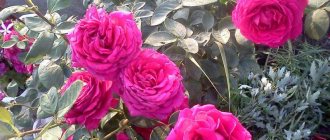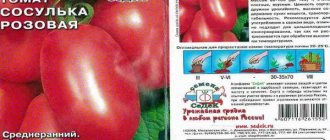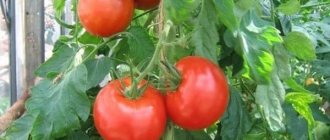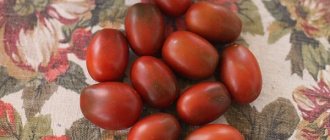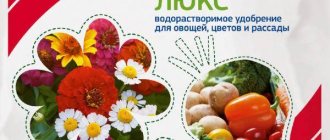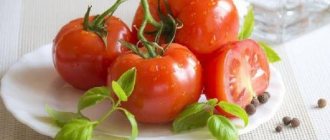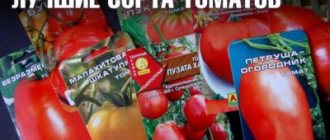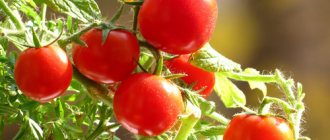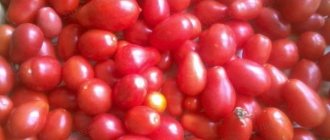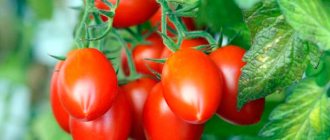Hybrid tomato Sun F1 is designed for protected soil. Its fruits ripen early and look very appetizing - orange, round and weighty. Sells seeds.
| Height | Landing location | Ripening time | Fruit color | Fruit size | Origin | Fruit shape |
| Tall | Greenhouse | Early ripening | Orange | Large | Variety | Round |
Tomato Scheherazade
Mid-season variety of Russian selection.
Designed for cultivation in open ground and film greenhouses. Productivity is average. Resistance to diseases and pests is high. The variety is cold-resistant and does not like high temperatures.
The plant is determinate, powerful, about 1 m in height (it grows higher in a greenhouse), with large dark green, heavily pubescent foliage. The bush needs staking and pinching (otherwise the fruits become smaller); it is better to form one to three stems.
The fruits are round-cylindrical in shape, with a spout, weighing 200-300 g, densely pubescent, orange-red in color. The skin is thick, the flesh is dense, juicy, sweet, with a pleasant aroma.
The fruits lie well and are easily transported. The purpose is universal - suitable for fresh consumption and whole-fruit canning.
Landing
Seeds can be planted in seedling boxes or immediately in separate containers - plastic or peat glasses, peat tablets. The latter method will allow you to avoid picking, and when using peat containers, to make the most gentle transplant to a permanent place and not damage the roots.
Before sowing, the seeds must be disinfected, since the variety is vulnerable to tobacco mosaic and Fusarium wilt. They are placed for half an hour in a weak solution of potassium permanganate, aloe juice or Fitosporin solution. Then it is useful to treat the seeds with a growth stimulant.
The soil for seedlings should have neutral acidity pH 6.5, be loose and rich in organic matter. The optimal balance of microelements is obtained by mixing the same amount of humus, peat and sand, a little wood ash and adding 2 tsp to the garden soil. mineral fertilizer.
Conditions for obtaining good seedlings:
- germination at a temperature of at least +25;
- further maintenance at a temperature of +18-22 (heat harms young sprouts, they stretch out and become weak);
- fertilizing 1-2 times;
- lighting approximately 12 hours a day.
At the age of 50-60 days, the seedlings are transferred to the site. It is placed according to a 50 by 60 cm pattern.
Tomato Wooly Blue Jay
Mid-season variety of American selection.
Designed for cultivation in open ground and film greenhouses. Productivity is high. Resistance to diseases and pests is average.
The plant is determinate, about 1 m in height (it grows taller in a greenhouse), spreading, with heavily pubescent green foliage with a bluish tint. The bush needs to be tied to a support and pinched; it is better to form it into three or four stems.
The fruits are round, pubescent, leveled, weighing 100-130 g, red-violet in color. The pulp is dark cherry, dense, juicy, medium-sweet, with a pleasant aroma.
The fruits lie well and are easily transported. The purpose is universal - suitable for fresh consumption and whole-fruit canning.
Tomato Ghost
Mid-season variety of Bulgarian selection.
Designed for cultivation in film greenhouses (planting in open ground is possible in the southern regions). Productivity is high. Resistance to diseases and pests is high.
The plant is indeterminate, tall, up to 2.5 m in height, with heavily pubescent foliage. The bush needs staking and pinching; it is better to form it into two stems.
The fruits are smooth, round in shape, weighing 60-100 g, slightly pubescent, pale orange-yellow in color with white strokes. The skin is thick, the flesh is dense, fleshy, juicy, sweet, with a pleasant aroma.
The fruits lie well and are easily transported. The purpose is universal - suitable for fresh consumption and whole-fruit canning.
Description and characteristics of the variety
Sun F1 is an early indeterminate hybrid, matures in 92-95 days. Intended for personal use and commercial cultivation. The weight of each fruit reaches 200 g. When ripe, the tomatoes are orange. The shape is round, the flesh is dense and juicy, with excellent taste.
Tomato Fluffy (woolly) blue wine (Woolly Blue Wine)
Mid-season variety of American selection.
Designed for cultivation in open ground and film greenhouses. Productivity is average. Resistance to diseases and pests is high.
The plant is indeterminate, tall, up to 2 m in height, with heavily pubescent foliage and stems.
The fruits are burgundy-red in color with deep purple shoulders, densely pubescent, weighing 80-120 g. The pulp is juicy, low-seeded, sweetish-sour with fruity notes, the skin is dense.
The fruits lie well and are easily transported. The purpose is primarily salad, although tomatoes are also excellent for whole-fruit canning.
Tomato Woolly Kate red (Wooly Kate)
Mid-season variety of American selection.
Designed for cultivation in open ground and film greenhouses. Productivity is average. Resistance to diseases and pests, as well as to the vagaries of the weather, is high.
The plant is determinate, about 1 m in height (it grows taller in a greenhouse), with heavily pubescent bluish-gray foliage. The bush needs staking and pinching; it is better to form it into three stems.
The fruits are round in shape, weighing 60-90 g, densely pubescent, orange-red in color, reaching blue-violet when fully ripe (darkening begins from the shoulders). The skin is thick, the flesh is red, dense, juicy, “oily,” sweet, with a pleasant aroma.
The fruits lie well and are easily transported. The purpose is universal - suitable for fresh consumption and whole-fruit canning.
Tomato-fruit L.A. Myazina
A couple of years ago on the website SEEDSPOST.ru in the “News” section I saw an offer to buy L.A. tomatoes. Myazina and immediately ordered everything that was offered... and did not regret it.
But in the first year I couldn’t plant everything (my desires did not coincide with my capabilities...) Yes, to be honest, I had no idea that they were so tasty and productive... That year I planted Pineapples, and Irish liqueurs, I really wanted sweet ones tomatoes, and they have appropriate names. And this spring at the exhibition I met the famous breeder Myazina Lyubov Anatolyevna, she talked there about how to grow tomatoes and about her varieties, of course... A very enthusiastic and charming woman. She drew our attention to the fact that all her hybrid tomatoes are created by classical selection methods, hand pollination, and the varieties are created through many years of selection and are not a product of genetic engineering. The State Register of the Russian Federation includes 25 varieties of its tomatoes (of which 11 are low-growing for OG of various shapes of fruits and different ripening periods, 3 varieties of cherry, 11 large-fruited) and 39 hybrids, of which fifteen are low-growing for OG for early harvest. Lyubov Anatolyevna advises soaking the seeds in a solution of manganese sulfate for 15 minutes (1 g per 200 ml of water), rinsing, holding in the Epin solution for 2 hours (2 drops per 100 ml of water), squeezing out and placing in a warm place (no higher than 25 degrees). On the second day of sowing, the seeds should not germinate until planting.
I planted one seed of each variety, and, of course, I would have gotten confused... Therefore, I poured “Krepysh” soil into a glass of water and planted 1 at a time. (If I plant two at a time, then I feel sorry for removing the excess growth, and I start planting them in different glasses - it’s a waste of time and harm to the roots, and again, extra seedlings...) She advises watering with warm water from 9 to 10 o’clock in the morning using a fine spray. He says that as a result, the root receives enough moisture and does not stretch down from the cup. I water it rarely, pour warm water over the edges of the glass and almost from a pipette, and even put it out on the cold balcony. It is important for me that the seedlings are short and strong, so it will be easier to transport them to the site from the city, and it will be easier for them to take root. To be honest, I brought seedlings no taller than 10 cm, because... At first I bought BIO land, but it was contaminated with something, and the seedlings began to “bend.” I put it out on a cold balcony and treated it so well against pests that it didn’t get any better... I decided to part with it and planted a new one in the Krepysh soil recommended to me on March 25th. And since it’s cold in my apartment, it took me a long time to sprout. Some were even heated up a little on the radiator. So, I brought these small things, without expecting a big harvest, of course, and carelessly planted them in a greenhouse. It was careless, because I didn’t dig up the soil. Last year's mulch did not rot and remained in a decent layer. I pulled it apart, there was “downy” soil underneath, I made holes in it, added a tablespoon of bone meal and a few granules of AVA fertilizer to them, planted the seedlings and returned the mulch to its place. You will say that all the infection remained in it... Maybe it did, however, I burned a sulfur bomb in a greenhouse in the fall... Myazina also advises, at the stage of one true leaf, to treat with Previkur for the development of the root system and against blackleg (15 ml Previkur per 10 liters of water ). At the two-leaf stage, treat with any copper-containing preparation. Before planting seedlings, treat against diseases with Acrobat (50g/10l of water) and against disease carriers with Confidor (5ml/10l of water). But I didn’t carry out any treatments (probably laziness, and I didn’t have these drugs either...) In the summer I only sprayed it with Fitosporin a couple of times.
feeding seedlings every 7 days. I throw a couple of granules of long-acting AVA fertilizer into a glass and hope that the plants themselves will take as much as they need; I don’t feed anything else. I’m probably wrong, but I always do better without “dancing with tambourines.” Well, that year I didn’t know that it was so difficult to grow peppers and eggplants, and they grew up gorgeous for me. And in the winter I found out... And this year the peppers grew, but very little... And the eggplants generally died at the seedling stage... And why did I read about them?... So, my harvest is not natural, but rather, probably, accidental... (And like this every year... Just kidding...)
She advises planting tomatoes in a greenhouse on the waxing moon. 2 weeks after planting, treat them for pests. Water in the morning... (As you already understand, I didn’t look at the moon...) And she also advises not to overdo it with fertilizing, otherwise there is a risk that the plants will become a green mass, and there will be few fruits themselves. So I didn’t feed my tomatoes. Lyubov Anatolyevna has varieties for greenhouses, greenhouses and pots (Cheerful Gnome, for example). I was already familiar with some of its varieties. This is the Cheerful Gnome - a productive and beautiful tomato, with elongated interesting fruits. I grow it every year in large flower pots and it never fails. It is very good in salads, preparations and for drying, because... there is little juice in it.
That year, I grew varieties in open ground: Snowman, Snow Queen, Northern Miracle, Snowfall, Snow White... Next to the tomatoes I left white cups with the varieties written on them, but the rain and sun erased what was written. At first I was upset, and then I thought that I needed the name to determine which variety was more productive, but they were all productive... And this year I planted her “ TOMATOES-FRUIT ” in the greenhouse. All varieties are meaty, juicy and very tasty, aromatic, with fantastic yield. Lyubov Anatolyevna advised me this. I stood and worried that there were so many varieties, and the greenhouse was not rubber. So she recommended them, and she also calculated that from 24 plants, I wouldn’t be able to harvest less than 130 kg of tomatoes... I didn’t weigh it, but I definitely collected no less... And my friends to whom I gave the extra seedlings also say that these tomatoes are the most productive and the seeds are asking... I planted them 40 cm from each other, formed them into two stems, although it was recommended to form one... But they somehow forked themselves, I didn’t interfere. Although I did cut off the second thick stem of one and regretted it later. Somehow I immediately realized that Mammoth (that’s the name of the variety) didn’t like it... And his harvest was smaller. But the tomatoes themselves were large and of excellent taste.
Mammoth tomato is early, sparsely leafy, 180 cm high, for growing in open ground and film greenhouses. The fruits are pink (mine are more likely light red), with thin skin, up to 500 g, flat-round, low-seeded, with sugary pulp and a wonderful aroma. The taste of the fruit is very high. The content of provitamin “A” is 2-3 times higher than in red-fruited tomatoes. If agricultural practices are followed, the yield per bush is up to 5 kg. Included by expert assessment in the State Register of the Russian Federation in 2007. Code 9463480. For me, they didn’t reach 500 g and there wasn’t 5 kg per bush (but I didn’t weigh it). I think it was because the second trunk was removed and it was a bit cramped. Next year I will plant this variety again and grow it into two trunks. It is very tasty. To confess your love for a particular variety, sometimes one year is not enough. You need at least three. I really like to collect the juice at the bottom of the salad bowl with bread. For this purpose you need juicy tomatoes. Her tomatoes turned out to be the juiciest: Balsam and Beauty Queen . Both varieties are early, tall (180 cm), powerful, weakly leafy, excellent taste, about 250-400 grams each. For fresh consumption and for all types of processing.
I used these varieties in salads and juice, because... they contain the most of it.
Queen of beauty
More dense, although also meaty and tasty were: Disco, Miss World, Lake of Hope, Doctor Summer, Indian Summer and Chelyabinsk Meteorite. Disko - fruits one to one, 350 grams each, bright red:
Miss World - in bunches of up to 10 tomatoes weighing 200 grams. How pleased I was with this variety! I collected it 4 times, and in October I still haven’t removed it... Tasty, productive, fruitful for a long time and not as tall as the others (120 cm). I’ll definitely plant it again!
Lake of Hope - delicious, red, 8-10 fruits, 250 grams each, on a simple cluster. Doctor Summer - with dense orange pulp.
Indian Summer , up to 180 cm high, medium leafy, fruits weighing 300 g, dense, round, smooth, fiery orange outside and inside, very tasty.
Chelyabinsk meteorite. Myazina writes about this tomato: “The hybrid Chelyabinsk meteorite is my gift to the tireless Vladimir Vasilyevich Stepanov, the head of the Chelyabinsk Research and Production Association “Gardens of Russia”, for his glorious anniversary. Ripe fruits are fiery orange in color, large, dense, with an “unearthly” taste.”
They are truly incredibly delicious!!! I will plant next year too.
I am very pleased with all these varieties, because I managed not only to put delicious salads in “basins” on the table every day, but also to marinate, salt, cook lecho, freeze and squeeze the juice so that I can drink it to my heart’s content, roll it up and freeze it, and also give it to my relatives and neighbors with delicious and beautiful tomatoes. The yield of these varieties exceeded all my expectations!
Tomato Pink Furry Boa
Mid-season variety of American selection.
Designed for growing in film greenhouses. Productivity is average. Resistance to diseases and pests is high. The variety is heat-loving.
The plant is indeterminate, powerful, tall (about 1.7 m in height), weakly leafy. The bush needs staking and pinching; it is better to form two or three stems.
The fruits are round in shape, weighing 120-150 g, slightly pubescent, pink in color with yellow-green stripes and strokes. The skin is thick, the flesh is dense, juicy, excellent taste with sourness, with a pleasant fruity aroma.
The fruits lie well and are easily transported. The purpose is universal - suitable for fresh consumption and whole-fruit canning.
